
[ad_1]
There has been 46.6 per cent growth in import value over the 12-month period and it pushes the US towards becoming one of the largest point-of-sale destinations for Australian wool after China and alongside other significant markets such as Japan, the UK, Italy, France, and Germany, according to the February Market Intelligence report by Woolmark and AWI.
Much of the growth in the US is due to the continued growth of merino wool in the active/outdoor market. According to Statista, sales in the sports and outdoor segment are projected to reach $24.93 billion this year. Revenue is expected to show an annual growth rate (CAGR 2023-2027) of 10.68 per cent, resulting in a projected market volume of $37.41 billion by 2027.
US wool apparel imports sharply surged in the later part of 2022, with imports for September-November 2022 being 20-35 per cent above their 2019 (pre-pandemic) levels. This has pushed the year-to-date import value around 30 per cent higher than 2019, as per a report. There has been 46.6 per cent growth in import value over the 12-month period.
Woolmark, the marketing arm of the research, development, and marketing body has for many years marketed merino wool’s naturally superior properties such as moisture-wicking, thermoregulation, odour resistance, and next to skin comfort across the outdoor sector as brands and manufacturers expanded. This often occurs at significant outdoor trade shows such as Outdoor Retailer, in Salt Lake City as well as equivalent events in Europe and Asia. This has also led to some on farm visits by US brands looking for a farm to fabric story. Woolgrowers often discount marketing as it more than often occurs a long way from Australia, but the active outdoor market is a good example of where marketing continues to yield results.
AWI’s chief executive John Roberts said: “The company’s offices are reporting positive signs for wool sales across the year. There is a real sense that 2023 will be a better year than 2022. Our team in China has told us that a high degree of normalcy has returned after the two-month long Omicron outbreak. Most of the textile mills are operating in full capacity since early January. The country’s GDP is set to bounce back and accordingly the level of optimism remains high among Chinese consumers—more than half of surveyed respondents believe their household income will increase over the next five years. With around 40 per cent of Australian greasy wool consumed by domestic consumers in China—that optimism should flow through to more sales.
“In Italy, our partnership with Prada Luna Rossa for the next America’s Cup has led to more than fifteen other brands to approach us to use wool in more sporting and outdoor wear. In Japan, the most recent winter campaign yielded a significant 12.9 per cent uplift in sales of the partner’s wool category, totalling $26 million in sales. Wool’s eco-credentials, particularly its biodegradability have resonated with Japanese consumers.”
There is a lot of wool to sell as the national flock continues to grow, the latest wool production forecast for 2022-23 remains at 340 million kgs greasy, up 5.0 per cent on the 324 Mkg estimate from 2021-22. The largest wool production state is New South Wales which is expected to lift by 3.2 per cent, with Victoria up 5.3 per cent, Western Australia up 5.7 per cent, South Australia up 5.3 per cent, Tasmania up 9.7 per cent, and Queensland up 13.5 per cent, added the report.
The average cut per head nationally is forecast to increase slightly to 4.54 kg greasy, the mean fibre diameter is 20.4 microns, staple length 90.5 mm, strength is 35.1 N/ktex, and the average national yield is 65.7 per cent.
Fibre2Fashion News Desk (NB)
[ad_2]
Source link